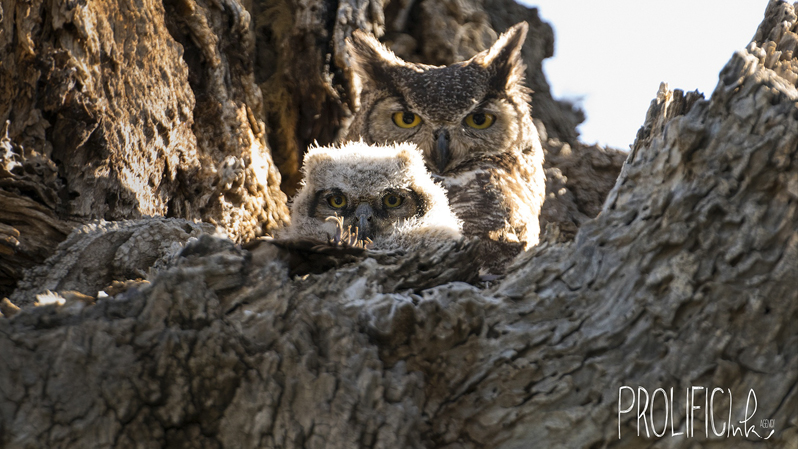The Story
It all started... a few years back when I purchased property in the northern Phoenix area. The previous owners told me about the "resident" owls that lived here. Residing in a tree fairly close to the house, it was easy to watch their activity and soon they became an interesting source of amusement. A few years later, it was discovered that the tree that housed them was dying and becoming unstable. Fearing that if the tree was removed, and the owls nesting spot gone, we would never see them again. So I decided to save their tree and support it with a "monument" of concrete boxing it in. Soon bark was falling off the tree, and we had it reattached with screws.
The owls home is now very secure and should provide many years of viewing pleasure. The interest in the owls has extended from family to friends and beyond. Recently, we decided to put up a camera so we can better view and share the "owl experience". That research led to meeting a local owl expert and learning about his organization, Wild at Heart.
Please enjoy the live video feed of our owls. If you are interested in Volunteering or Donating to the Wild at Heart organization please look for more information at their website: www.wildatheartowls.org
Frequently Asked Questions
What kind of owl is the one nesting?
Great Horned Owl
How long does it take for an egg to hatch?
The eggs hatch in about 4 weeks. Great Horned Owls are very protective parents and will attack intruders. Young Great Horned Owls clamber out of the nest to nearby branches where they flap their wings and make short, cautious flights, while they continue to be fed by their parents. They will be able to fly when they are 9-10 weeks old.
What does it eat?
Great Horned Owls have the most diverse diet of all North American raptors. Their prey range in size from tiny rodents and scorpions to hares, skunks, geese, and raptors. They eat mostly mammals and birds—especially rabbits, hares, mice, and American Coots, but also many other species including voles, moles, shrews, rats, gophers, chipmunks, squirrels, woodchucks, marmots, prairie dogs, bats, skunks, house cats, porcupines, ducks, loons, mergansers, grebes, rails, owls, hawks, crows, ravens, doves, and starlings. They supplement their diet with reptiles, insects, fish, invertebrates, and sometimes carrion. Although they are usually nocturnal hunters, Great Horned Owls sometimes hunt in broad daylight. After spotting their prey from a perch, they pursue it on the wing over woodland edges, meadows, wetlands, open water, or other habitats. They may walk along the ground to stalk small prey around bushes or other obstacles.
How big does the Great Horned Owl get?
Length 18.1–24.8 in 46–63 cm
Wingspan 39.8–57.1 in 101–145 cm
Weight 32.1–88.2 oz 910–2500 g
A note on the unhatched Egg you see
94.2 % of Great Horned Owl eggs hatch. The reasons why they would not hatch range from: an inexperienced female, inadequate food supply, a disturbed nest, infertility, to low temperature and addled because they were left unattended too long. We are not 100% sure why this one didn't hatch. There seems to be adequate food, the temperature has been above freezing, the nest has never been disturbed and the parents are very experienced. I would guess it is infertile, since it didn’t hatch with the other two.
Why does the camera disconnect after 5 minutes?
People tend to leave it open in another window and that uses up a lot of bandwidth which we end up paying for. We would rather as much money as possible to go towards the Wild At Heart Organization. We may look into other options as things move forward.
Does the spotlight bother the owls at night?
Note about the new "spotlight" - We have added an IR Illuminator light in hopes to make the night time a better viewing experience. We realize to us it looks pretty bright, we are working on getting it dimmed a bit. An IR illuminator, to the camera, looks like a bright light bulb on the ceiling. But the owls (and humans) just see a very faint red glow. This special type of light should not have any effect on the owls even know it may look that way.
Credits
A big thanks to the Cornell Lab of Ornithology for all the research they do and the information they provide on their website. To learn more about Great Horned Owls and other birds, please visit their website: http://www.allaboutbirds.org/guide/great_horned_owl/lifehistory
Nesting Facts
Clutch Size:
1–4 eggs
Number of Broods:
1 broods
Egg Length:
2.1–2.2 in 5.3–5.6 cm
Egg Width:
1.8–1.9 in 4.5–4.7 cm
Incubation Period:
30–37 days
Nestling Period:
42 days
Egg Description:
Dull white and nearly spherical, with a rough surface.
Condition at Hatching:
Helpless, with closed eyes, pink skin, and white down on upperparts.





